38 results
Biology worksheet interactive whiteboards
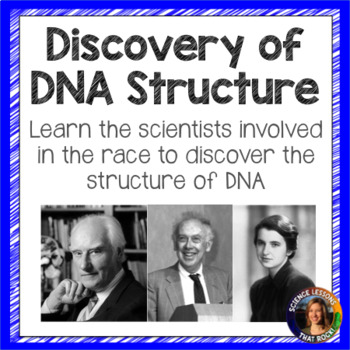
Discovery of DNA lesson and student notes
This lesson includes a Powerpoint and an accompanying student worksheet on the discovery of DNA. Students will learn about the main scientists that contributed to the discovery of the double helix. Scientists included are: Avery, Pauling, Franklin, Wilkins, Chargaff, Watson, and Crick. There is a video linked included that can also be shown as students fill out the worksheet. ⭐ New! Included in your purchase is a guided YouTube lesson that walks students through the powerpoint. Great for blende
Subjects:
Grades:
8th - 12th
Also included in: DNA and Protein Synthesis Bundle
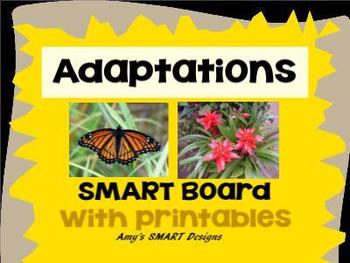
Adaptations: Plant and Animal SMART Board Lessons with printables
This Science SMARTboard unit consists of 33 slides and 10 paper attachments.
The unit is divided into three parts: Animals Adaptations, Plant Adaptations, and Changing Ecosystems.
The SMART lessons are interactive with animation, sound, and links to further your students' knowledge. There are two slides of vocabulary interactive games to conclude the unit.
There are 3 attached worksheets for animals adaptation, 2 for plant adaptation and one for changing ecosystem. (see preview)
Also attac
Subjects:
Grades:
2nd - 4th
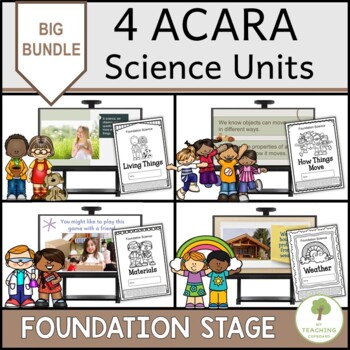
BIG KINDERGARTEN SCIENCE BUNDLE - 4 ACARA Foundation Stage Science Units
This big kindergarten science bundle covers the ACARA foundation stage Biological, Chemical, Earth and Space & Physical sciences. Teach your students about LIVING THINGS, MATERIALS & THEIR PROPERTIES, WEATHER and HOW THINGS MOVE. A whole year's worth of lessons and worksheets. Includes 40 PowerPoint lessons and 4 corresponding student Science Journals. You will have everything you need to teach the ACARA Foundation Stage Science Curriculum. The highly engaging Powerpoint lessons and the
Subjects:
Grades:
K
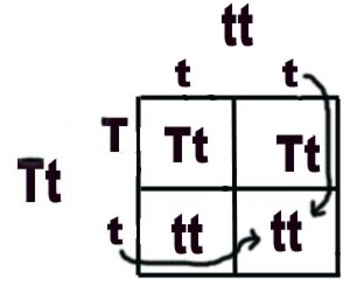
Mendelian Genetics Unit: Lesson 6: Intro to Punnet Squares
Before students can continue their monster project, they need to learn how to organize information about alleles, and predict future offspring using Punnet squares!
This lesson focuses on how to organize information without a Punnet square, and looks at the pros and cons of solving a different way, then shows the more streamlined Punnet squares with side by side comparisons so students can see the exact same information is in both.
There are levels of practice problems ranging from simple (fil
Subjects:
Grades:
6th - 8th
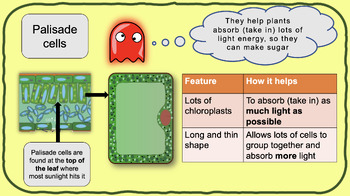
Cells and Organisation - 4 lesson bundle - low ability/special ed/SEND
A series of PowerPoints and resources designed with the young struggling scientist in mind and those with additional learning needs. The focus is on accessibility to the content and is generally of low demand. The PowerPoints use a dyslexia-friendly template in which font, background and character spacing increase readability. Animations enhance understanding of abstract concepts, rather than distract from the learning.Lesson 1 - Animal cell structure and cheek cell practical/labLesson 2 - Pla
Grades:
6th - 8th
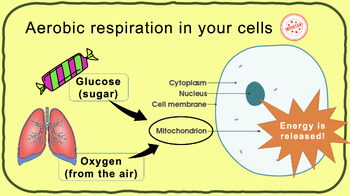
Respiration and Breathing - 4 lesson bundle - low ability/special ed/SEND
A series of PowerPoints and resources designed with the young struggling scientist in mind and those with additional learning needs. The focus is on accessibility to the content and is generally of low demand. The PowerPoints use a dyslexia-friendly template in which font, background and character spacing increase readability. Animations enhance understanding of abstract concepts, rather than distract from the learning.Lesson 1 - Free resource. Aerobic respiration in simple terms. Free crosswo
Grades:
6th - 8th
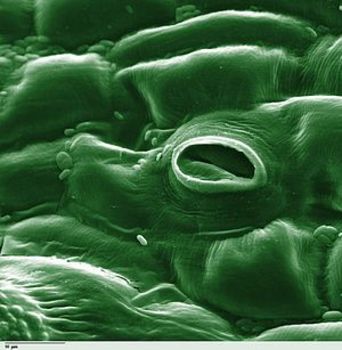
Plants: Lesson 2: Transpiration & the Xylem
In this lesson, students will take the journey through a plant via the perspective of a water droplet (traveling with a mineral). By reading an adventure-like story and illustrating it, the teacher can easily check for understanding, then later, explain the science behind what is happening.
By using a story instead of a boring text, students are more engaged and visualize processes much better. This then, can provide an excellent foundation for building vocab or understanding larger scientific
Subjects:
Grades:
6th - 8th
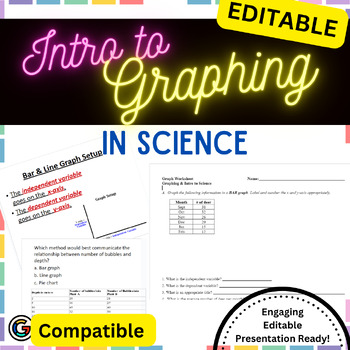
EDITABLE Intro to Graphing-High School- Slides and Activity- Biology- Science
Are your students struggling to identify which graph to use for a specific type of data table? Are they struggling to simply identify what goes on the X and Y axis? This lesson introduces students to data tables and graphs, teaches students how to create data tables from data, how to interpret tables and graphs, and offers hands-on opportunities to create data tables and graphs. It includes the following resources:1. EDITABLE Google Slides that covers:Different types of graphs (line, bar, pie)T
Subjects:
Grades:
7th - 10th

Plant Cells (inc. cheek cell lab) - low ability/special ed/SEND
Please watch the (speeded up!) video preview of the slideshow.A PowerPoint to guide students through an introduction to plant cells. To be used in conjunction with the classic onion cell slide prep. lab. Video guidelines included for the microscope activity. This lesson is a follow on from my lesson on animal cells.It has a little built in assessment, although you'll probably need to use something you already have in addition. There are crosswords to help reinforce the keywords and their defi
Grades:
6th - 8th
Also included in: Cells and Organisation - 4 lesson bundle - low ability/special ed/SEND
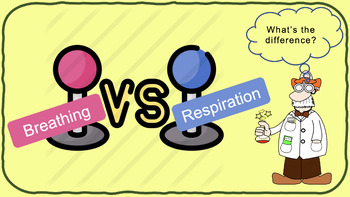
Lungs and Breathing - low ability/special ed/SEND
Check the video preview for a run-through of the resource. A PowerPoint guides a lesson on lungs and breathing. It highlights the differences between respiration and breathing. Could be used in conjunction with the bell-jar demonstration of lungs and diaphragm, and even better a lab demo of sheep lungs. What's more fun than connecting a blower to a pair of lungs! There's also a fun interactive quiz that could have students coming up to press on the interactive whiteboard.Crosswords help emb
Grades:
6th - 8th
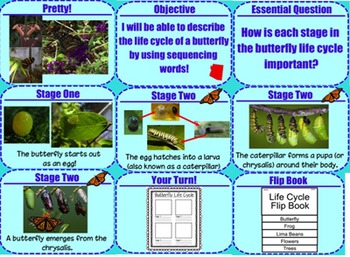
Life Cycles Bundle
This lesson walks through the life cycle of butterflies, frogs, lima beans, flowers, conifer trees, and fruit trees.
These lessons includes:
-Objective and Arizona State Standards
-Essential Questions
-Agendas
Step by Step walk through of the stages of the butterfly life cycle
Step by Step walk through of the stages of the frog life cycle
-Step by Step walk through of the stages of the lima bean life cycle
-Step by Step walk through of the stages of the flower life cycle
-Step by Step walk thro
Subjects:
Grades:
1st - 6th
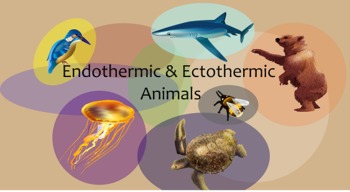
Endothermic and Ectothermic Animals Minilesson w/ SmartBoard
This is a minilesson addressing 6th grade science standards on endothermic (warm-blooded) and ectothermic (cold-blooded) animals. I used this with students as we were studying the characteristics of vertebrates and invertebrates.
Included in this lesson is:
-A 9 page SmartBoard file for students to complete as a class or individually.
-A 4 page worksheet mirroring the SmartBoard lesson for students to work along.
-A 1 page reading passage on the characteristics of endotherms and ectotherms.
Grades:
5th - 8th
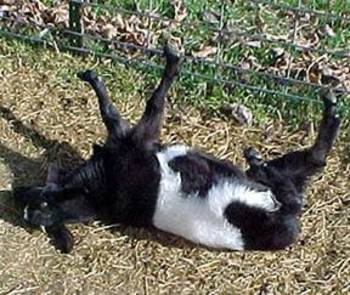
Mendelian Genetics Unit: Lesson 1: Inherited vs. Acquired Traits
This lesson (60-80 minutes) was created to introduce genetics to 6-8th graders by introducing the word "trait"-- students will identify traits (initially physical, but then medical and behavioral) in celebrities and themselves that are both "inherited" or "acquired" and discuss how traits are passed on, and which traits pass on genetically.
Students will work individually and in groups, discuss traits, watch a short web cartoon from Learn.Genetics, make a foldable, read about traits, categoriz
Subjects:
Grades:
6th - 8th
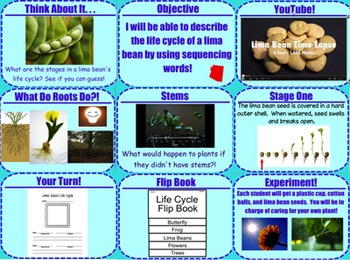
Plants Life Cycle Bundle
This lesson walks through the life cycle of lima beans, flowers, conifer trees, and fruit trees.
These lessons includes:
-Objective and Arizona State Standards
-Essential Questions
-Agendas
-Step by Step walk through of the stages of the lima bean life cycle
-Step by Step walk through of the stages of the flower life cycle
-Step by Step walk through of the stages of the confer tree life cycle
-Step by Step walk through of the stages of the fruit bean life cycle
-Time lapse videos to show how th
Subjects:
Grades:
1st - 6th

Activity to Identify variables
Great group activity that allows students to work together to identify independent and dependent variables. There are 9 stations - students read the scenario and fill in work sheet provided. I have them rotate every 2-3 minutes. Answer key provided. SMARTboard presentation included that has the scenarios and a PDF for you to print cards. I print each scenario on ans 8.5 x 11 card stock paper for durability as they get used. Two scenarios are deleted so that is why you see 2 numbers miss
Subjects:
Grades:
6th - 9th
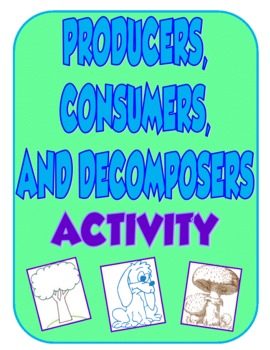
Producers, Consumers, and Decomposers Activity
This fun activity I complete with my students during my ecosystem unit. After our discussion of producers, consumers and decomposers, I pass out the worksheets. Students work with a partner to classify, cut and paste the pictures onto the chart. When all have finished, I have groups come to the smartboard and drag a picture into the appropriate column. You could also do the drag activity first and then pick up the cut and paste activity for assessment. The kids really enjoy it. It's not to
Subjects:
Grades:
3rd - 5th

Living Things - A Third Grade Smartboard Introduction
This lesson focuses on an introduction to organisms. It includes: a Smartboard presentation of the text emphasizing the properties of living things including characteristics of living things, make up of living things (with introduction to Robert Hooke), and plant/animal cells similarities and differences. Terminology is included, a “Creation of Your Own Animal” activity (in Word format), as well as two SmartBoard activities (identifying the parts plant and animal cells and characteristics of liv
Subjects:
Grades:
2nd - 4th
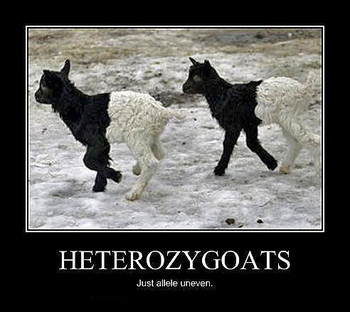
Mendelian Genetics Unit: Lesson 4: Homozygous & Heterozygous
Key terms: gene, allele, phenotype, genotype, dominant, recessive, homozygous, heterozygous, genetics
Building on the previous 3 lessons, students will look for the connection between genotypes and phenotypes, differentiate between homozygous and heterozygous genotypes, complete word studies and graphic organizers, predict possible offspring based on observable traits, use genotypic codes, solve crossword puzzles for vocabulary review and more.
This can be taught in 60-90 minutes. The lesson
Subjects:
Grades:
6th - 8th
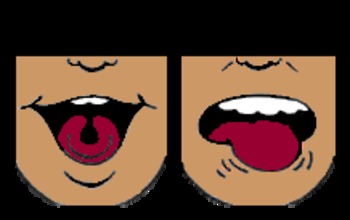
Mendelian Genetics Unit: Lesson 3: Dominant vs. Recessive
Students will review:
1. The difference between inherited and acquired traits
2. The distinction between a gene and alleles
Students will then identify and define dominant and recessive phenotypes, look for word connections for the new vocabulary, create analogies for dominant and recessive alleles, identify their own dominant and recessive traits, create a foldable illustrating a "totally dominant" and "totally recessive" cartoon person, fill out and create their own graphic organizers and mo
Subjects:
Grades:
6th - 8th
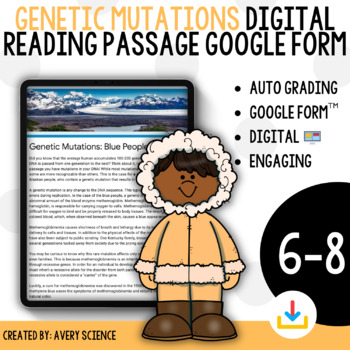
Genetic Mutations Science Literacy Digital Reading Passage Google Form
Overview:Effortlessly incorporate science literacy into your genetic mutations lesson with this digital reading passage from Avery Science. Students will learn about the genetic mutation methemoglobinemia, which causes blue skin, then answer test-style multiple choice reading comprehension questions. A perfect warm-up, homework assignment, independent assignment, or literacy assessment.Looking for the printable version of this resource? Check it out HERE.Why You'll Love It:Low-prep, download and
Subjects:
Grades:
6th - 9th
NGSS:
MS-LS3-1
Also included in: Life Science Biology Mega Resource Bundle
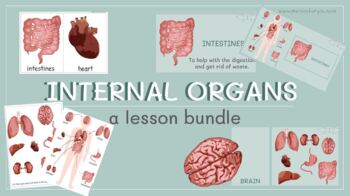
An Interactive Bundle 'Internal Organs' (Online and Offline classes)
An Interactive Bundle Internal Organs:Vocabulary:1. intestines;2. a heart;3. lungs;4. a liver;5. kidneys;6. a stomach;7. a brain.There are:Number 1. a Worksheet ( match and write the organs);Number 2. seven Flash Cards;Number 3. Printables: a poster, a printable game (print and cut the organs and put them on the printable body), a matching game (match the organs and their functions);Number 4. an Interactive Power Point Presentation with Games#1 Learn the new vocabulary and find the organs in the
Grades:
2nd - 7th
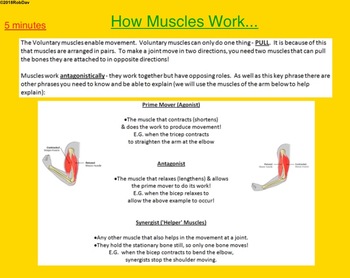
Anatomy & Physiology - 9 - How Muscles Work
Complete pack of lesson resources to teach Anatomy & Physiology - 9 - How Muscles Work.
Lesson Name:
1. How Muscles Work
Resources:
1. Presentation (SMART Notebook Version)
2. Presentation (PDF Version)
3. Worksheet (Word)
Please Note (about my resources in general):
1. Resources produced by myself show: '©2018RobDav’
2. SMART Notebook & PDF files will open as normal
3. Powerpoint & Word files are protected and you will be asked
to open these as 'Read Only’
4. Copy and / or edit t
Subjects:
Grades:
6th - 10th
Also included in: Option / Theory PE Bundle - 15 Lessons - Anatomy & Physiology
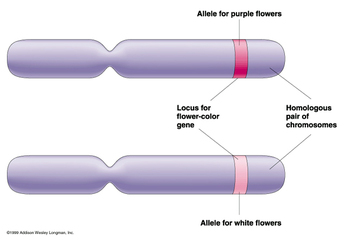
Mendelian Genetics Unit: Lesson 2: Genes vs. Alleles
In this second lesson, students dig deeper into inherited traits to define a gene, the placement of a gene on DNA/a chromosome, and the relationship between a gene and an allele. Teaching time-- 60-90 minutes.
Included: web links, worksheets, graphic organizers, answer keys, guided notes
Key words: gene, allele, genetics, inherited trait, acquired trait, phenotype, chromosome, DNA
There are additional activities for a second day which may also be exchanged with the first, used in centers, use
Subjects:
Grades:
6th - 8th
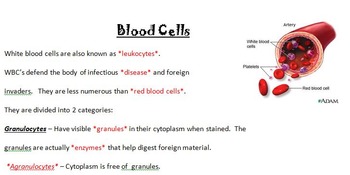
Blood Cells Open Notes and KEY
This is an assignment created in Word in open notes format style. I use this type of activity with a Promethean Board/projector. Open notes are a great way to introduce or review material with the students without requiring them to take copious handwritten notes. The open notes assignment is basically typed paragraphs with fill-in-the-blanks for the students. The teacher uses the key to provide the answers. I use a projector, but if you don't have or use one then you can simply provide the
Grades:
9th - 12th
Showing 1-24 of 38 results





